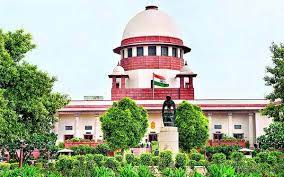22 Sep Supreme Court permits live streaming of proceedings of all Constitutional Bench
Supreme Court permits live streaming of proceedings of all Constitutional Bench
The Supreme Court recently allowed live streaming of its proceedings in important Constitutional Bench cases from September 27. A constitutional Bench is a bench of the Supreme Court having five or more judges on it.

Supreme Court permits live streaming
BACKGROUND
- In 2018, The Apex Court in Swapnil Tripathi v Supreme Court of India declared a live telecast of Court Proceedings as part of the Right to Access Justice under Article 21 of the Constitution which deals with the Protection of Life and Personal Liberty.
- Consequently, “Draft Model Rules for Live-streaming and Recording of Court Proceedings” were released to regulate the live streaming of court proceedings.
- Virtual hearings of court proceedings became common with the onset of the COVID pandemic but these were restricted to the parties to dispute and were not accessible to the general public.
- In 2021, a PIL on concerns of COVID, suo moto taken up by the Gujarat High Court was live-streamed and was viewed by more than 94,000 people.
- Currently, the Gujarat, Patna, Jharkhand, Karnataka, Orissa, and Madhya Pradesh High Court have already been live streaming their proceedings through Youtube.
RESTRICTIONS
The Court may refuse to allow streaming of live proceedings in the following cases as suggested by the Attorney General of India, KK Venugopal:
- Matrimonial matters,
- Matters involving the interests of juveniles or the protection and safety of the private life of young offenders,
- Matters of National security
- To ensure that victims, witnesses or defendants can depose truthfully and without any fear.
- To protect confidential or sensitive information, including all matters relating to sexual assault and rape,
- Matters where publicity would be antithetical to the administration of justice, and
- Cases that may provoke sentiments and arouse passion and provoke enmity among communities.
BENEFITS OF LIVE STREAMING PROCEEDINGS
The move will have great significance as will pave way for the following positive outcomes:
- It will lead to de-congestion of courts
- It would remove the need for people to come to Delhi from distant states for a day’s hearing.
- It will lead to more transparency, inclusivity, and better access to justice
- Increase legal literacy and the public’s engagement with the Constitution and laws of the land.
- Improve the quality of conduct of the legal fraternity particularly lawyers and bring more decorum and discipline.
- Promote the flow of real-time information
- Various matters of national importance are lined up for hearing like petitions challenging the quota for economically weaker sections (EWS), hijab ban, and Citizenship Amendment Act (CAA), the ex-communication in the Dawoodi Bohra community, petition for enhanced compensation for victims of 1984 Bhopal gas tragedy, the and SC’s power to dissolve marriages on the grounds of irretrievable breakdown. Hearing on such issues of national and public interest deserves to be watched by the public.
CONCERNS OF LIVE STREAMING PROCEEDINGS
The decision has given rise to certain issues and concerts like:
- It may lead to sensationalization and disinformation as clips may be circulated irresponsibly with catchy sensational titles to garner views effectively leading to fake news and propaganda.
- People may be misled by watching snippets of the hearing when in reality everything needs to be viewed as a whole
- This may lead to self-censorship by Judges and lawyers to escape criticism of unpopular opinions. This goes against constitutionalism as judges are sworn to constitutional morality and not popular morality
- It may hamper genuine courtroom engagement
- Issues of Lack of technical manpower in courts and awareness amongst litigants and advocates as well as their acceptance of the system change is also there.
- May be susceptible to cyber attacks
- Lack of Infrastructure and high-speed internet connectivity
WAY FORWARD
The introduction of live streaming is a welcome step to enhance the justice delivery system in India. As the Supreme Court pointed out in Swapnil Tripathy vs Supreme Court, “sunlight is the best disinfectant. Live-streaming will ensure that the interface between a court hearing with virtual reality will result in the dissemination of information in the widest possible sense, imparting transparency and accountability to the judicial process” However, this must be implemented with caution as Ex-CJI N.V. Ramana stated, “A judge cannot be swayed by popular opinion. Yes, with increased public gaze, he might become a subject of multiple debates, which should never deter him from his duty to protect the right of one against the might of many. Always remember, as a repository of people’s faith, a judge cannot afford to lose objectivity,” while to lawyers, he said, they should watch over their client’s interests rather than vie for publicity.
SOURCES:
- The Indian Express (Live streaming of SC proceedings: the rationale and the concerns)
- The Indian Express (Why we should, and should not live stream Supreme Court proceedings)
- The Hindu
- The Daily Guardian
- The Tribune
Download PDF now:
Plutus IAS Daily Current Affairs Eng Med 22 Sep 2022
IAS Current Affairs
Get the latest and best daily current affairs for the UPSC examination from Plutus IAS. It is the best coaching for PSIR optional. Read weekly and monthly current affairs also from us.



No Comments